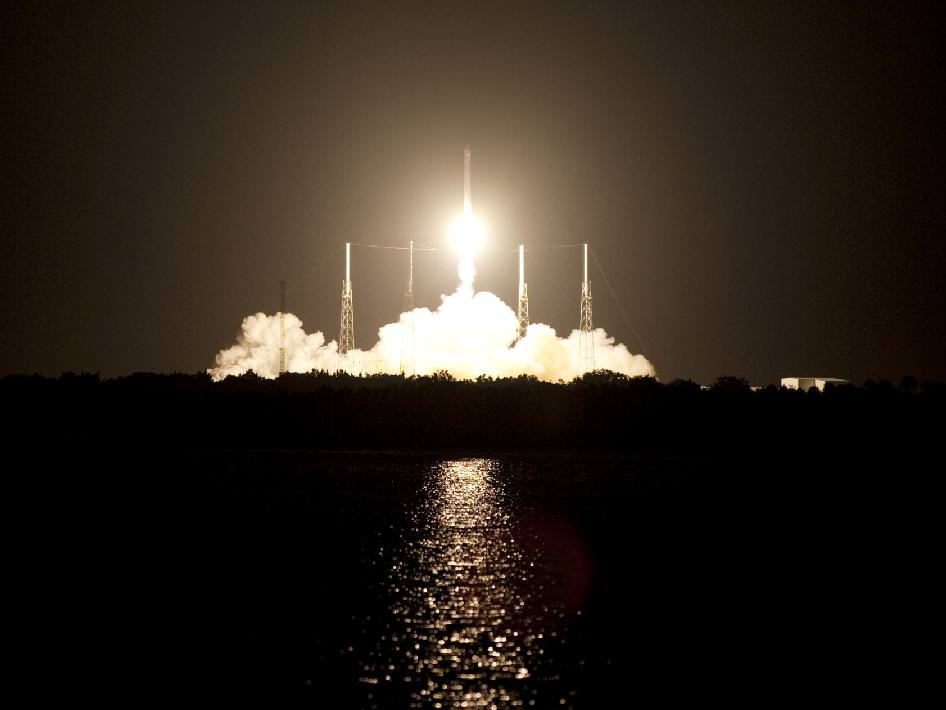During last night's launch of the Dragon capsule by SpaceX's Falcon 9 rocket, there was an anomaly on one of the rocket's nine engines and it was shut down. But Dragon still made it to orbit – just a little bit later than originally expected. At about 1:20 into the flight, there was a bright flash and a shower of debris. SpaceX's CEO Elon Musk
issued a statement
about the anomaly saying:
"Falcon 9 detected an anomaly on one of the nine engines and shut it down. As designed, the flight computer then recomputed a new ascent profile in realtime to reach the target orbit, which is why the burn times were a bit longer. Like Saturn V, which experienced engine loss on two flights, the Falcon 9 is designed to handle an engine flameout and still complete its mission. I believe F9 is the only rocket flying today that, like a modern airliner, is capable of completing a flight successfully even after losing an engine. There was no effect on Dragon or the Space Station resupply mission."
UPDATE (2 pm EDT 8/10):
SpaceX
has now provided an update and more information: the engine didn't explode, but (now updated from a previous update), "panels designed to relieve pressure within the engine bay were ejected to protect the stage and other engines." Here's their statement:
Approximately one minute and 19 seconds into last night's launch, the Falcon 9 rocket detected an anomaly on one first stage engine. Initial data suggests that one of the rocket's nine Merlin engines, Engine 1, lost pressure suddenly and an engine shutdown command was issued. We know the engine did not explode, because we continued to receive data from it. Panels designed to relieve pressure within the engine bay were ejected to protect the stage and other engines. Our review of flight data indicates that neither the rocket stage nor any of the other eight engines were negatively affected by this event.
As designed, the flight computer then recomputed a new ascent profile in real time to ensure Dragon's entry into orbit for subsequent rendezvous and berthing with the ISS. This was achieved, and there was no effect on Dragon or the cargo resupply mission.
Falcon 9 did exactly what it was designed to do. Like the Saturn V (which experienced engine loss on two flights) and modern airliners, Falcon 9 is designed to handle an engine out situation and still complete its mission. No other rocket currently flying has this ability.
It is worth noting that Falcon 9 shuts down two of its engines to limit acceleration to 5 g's even on a fully nominal flight. The rocket could therefore have lost another engine and still completed its mission.
We will continue to review all flight data in order to understand the cause of the anomaly, and will devote the resources necessary to identify the problem and apply those lessons to future flights. We will provide additional information as it becomes available.
In their initial press release following the launch SpaceX had originally described the performance of Falcon 9 as nominal "during every phase of its approach to orbit."
During the press briefing following the launch SpaceX President Gwynne Shotwell replied to a question about the flash and said "I do know we had an anomaly on Engine 1, but I have no data on it. But Falcon 9 was designed to lose engines and still make mission, so it did what it was supposed to do. If you do end up with issues, you burn longer to end up where you need to go."
SpaceX's website also mentions this capability,
saying, ""This vehicle will be capable of sustaining an engine failure at any point in flight and still successfully completing its mission. This actually results in an even higher level of reliability than a single engine stage."
Dragon made it to orbit about 30 seconds later than originally planned, but Shotwell said it made it into the correct orbit, "within two or three kilometers in both apogee and perigee and Dragon is now on its way to Station." The anomaly happened right at the time of Max-Q, just as the vehicle went supersonic.
The Space Shuttle was also designed to make it into orbit even if one of its three engines failed – after a certain point in the flight – and did so at least once to this reporter's knowledge, on STS-51-F which resulted in an Abort To Orbit trajectory, where the shuttle achieved a lower-than-planned orbital altitude.
This was the first time SpaceX made lift-off at their originally planned "T-0" launch time, Shotwell noted. And they also deployed a tag-along, secondary payload in addition to the Dragon capsule, a prototype commercial communications satellite for New Jersey-based
Orbcomm Inc.
However,
A report by Jonathan McDowell indicates
the Orbcomm satellite is being tracked in low orbit instead of its elliptical target orbit because the Falcon 9 upper stage failed its second burn. (More info here from
Jonathan's Space Report).
SpaceX will undoubtedly review the anomaly, and we'll provide more information about it when available.
SpaceX Launches to the International Space Station. Credit: NASA
 Universe Today
Universe Today
